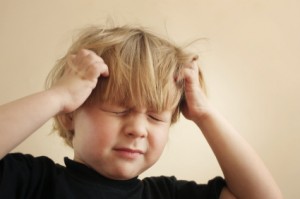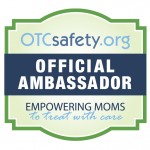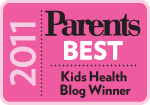 Yes, lice happens. It just does. Your child will either be afflicted with this pest at some point in her life, or you will spend some time hoping she doesn’t get those itchy bugs because inevitably someone in her class/preschool/dance class will have had it. And you’ll itch just thinking about it.
Yes, lice happens. It just does. Your child will either be afflicted with this pest at some point in her life, or you will spend some time hoping she doesn’t get those itchy bugs because inevitably someone in her class/preschool/dance class will have had it. And you’ll itch just thinking about it.
Although certainly more common when school is in session, lice knows no boundaries or seasons. In fact, I’ve seen quite a few cases this summer. Head lice are extremely common in school age children. Head to head contact and being in such close proximity makes it easy for lice to spread quickly.
We had our own brush with these little critters when a few of my son’s kindergarten mates became infested during this past school year. A note was sent home to “be on the lookout” and all the children were checked for nits by the school nurse. I was walking on pins and needles for the next couple of weeks, because even though lice is fairly inconsequential in the long run, it can be down right annoying and labor intensive to treat.
Detecting lice can be difficult at first. It is much more common to find nits than an actual live louse. The nits, which are the lice eggs, are usually located very close to the scalp and are attached to the hair shaft. You can differentiate these nits from plain old dandruff or product residue by trying to remove them with your fingers. Dandruff and other products should easily come off, nits do not.
Itching is a sign of lice infestation; however, children can have lice for weeks before they start feeling itchy. They may complain that it feels like something is tickling their head. Check for lice near the nape of the neck and around the ears first, as they tend to appear here. Look under bright light and separate hair so you can clearly see the scalp. Do this around the whole head if you suspect lice. If you see any suspicious nits or lice, and they cannot be removed easily by hand, it’s quite possible your child has lice.
Okay, so now what? How should the treatment strategy go? There are various techniques and methods these days. Natural remedies are also on the rise and some prove to be quite effective.
Here is the treatment strategy I was ready to employ, just in case I found lice on my son’s head:
- The mainstays of treatment are killing the lice and nits and mechanical nit removal followed by precautions to prevent re-infestation.
- First, start with a medicated shampoo such as Nix. Nix is a 1% permethrin pesticide shampoo, it kills both the lice and the nits. It’s not always 100% effective, but it’s a good start. This is the safest of the pesticide shampoos.
- Follow the shampoo treatment with extensive nit combing. Special combs designed to remove nits should be used. Be sure to use on hair that is wet and either has some sort of cream rinse on the hair to make the nit combing easier.
- Keep combing until no nits come out. Comb daily over the next week with a nit comb.
- Use shampoo with tea tree oil to prevent re-infestation. It has been shown, that tea tree oil can prevent lice re-infestation.
- Between 10 to 14 days, repeat the initial lice treatment. You can choose to go with the same pesticide shampoo or try using olive oil or Vaseline on the hair and cover with a shower cap for 8-10 hours. Then repeat nit combing until clear.
Try not to go crazy with washing all household items. Wash the child’s bedding, towels, and recently worn clothes. Lice cannot live more than 1-2 days without a human host. If needed, put items that cannot be washed, such as stuffed animals, in an airtight bag for two weeks.
Most of all, realize that lice is extremely common in ages 3-12. It has nothing to do with poor hygiene or low socioeconomic status. Anyone can get it and any stigma associated with it is unnecessary. Your child may return to school/summer camp/dance class once treatment has begun and nits have been combed out. This should be the very next day. Just remember that the next two weeks are important for ongoing treatment (nit combing and repeat shampoo treatment) and for remaining vigilant on checking for new nits or lice.
Has lice affected your children? What methods did you use to get rid of it?









I remember when my brother and I got lice as kids. My mom was horrified about it!
Lice creeps me out….dreading the day!
As a teacher this is always a concern. I have been so lucky to have dodged them despite being regularly surrounded by them. It's always fun to watch a line up of teachers picking "lice letters" (notices home to parents) up at their mailboxes…the simultaneous scratching is hilarious. That said, one way we've preached about getting rid of lice in hard to wash things is to put them in a bag and pop them in the freezer. Not sure how effective it is. There are also battery operated nit combs.
I dread the day I have to deal with them personally!
One of my kids kept getting re-infected with lice during the last school year. It was awful. Just when we thought we were done, we would have it again. We used over the counter remedies to clear it up each time (and once even tried a prescription shampoo and another time a mayonnaise home remedy), but it wasn’t until I read your advice about using shampoo with tea tree oil after the over the counter treatment that we were finally able to say goodbye to lice! We haven’t had it return since and hopefully it will stay that way. Now the whole family is hooked on Organix Tea Tree Mint Shampoo! Thanks for the great advice!
Getting lice can really be a big hassle. But remember there are more than plenty ways to get rid of it. Non-toxic lice removal solutions, household remedies like mayonaise and much more. Just follow the instructions and be patient.